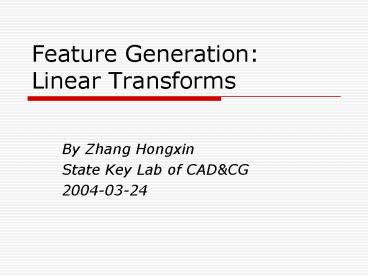Feature Generation: Linear Transforms - PowerPoint PPT Presentation
Title:
Feature Generation: Linear Transforms
Description:
Remarks of PCA. Total variance ... Problem of PCA. Independent component analysis ... Perform a PCA on the input data. Step2. ... – PowerPoint PPT presentation
Number of Views:56
Avg rating:3.0/5.0
Title: Feature Generation: Linear Transforms
1
Feature Generation Linear Transforms
- By Zhang Hongxin
- State Key Lab of CADCG
- 2004-03-24
2
Outline
- Introduction
- PCA and SVD
- ICA
- Other transforms
3
Introduction
- Goal choosing suitable transforms, so as to
obtain high information packing. - Raw data -gt Meaningful features.
- Unsupervised/Automatic methods.
- To exploit and remove information redundancies
via transform.
4
Basis Vectors and Images
- Input samples
- Unitary NxN matrix A and transformed Vector
- Basis vector representation
5
Basis Vectors and Images (cont)
- When X is an image, A is a huge piece of
bread to eat ( ) - An alternative possibility
- Let U and V be two unitary matrices,
and - Then
Y is diagonal
6
The Karhunen-Loeve Transform
- Goal to generate features that are optimally
uncorrelated, that is, - Correlation matrix
- is symmetric, A is chosen so that its columns
are the orthonormal eigenvectors of
7
Properties of KL transform
- Mean square error approximation
- Error estimation
Approximation!
8
Principle Component Analysis
- Choosing the eigenvectors corresponding to the m
largest eigen-values of the correlation matrix,
to obtain minimal error - This is also the minimum MSE, compare with any
other approximation of x by an m-dimensional
vector. - A different form computing A in terms of
eigen-values of the covariance matrix.
9
Remarks of PCA
- Total variance
- From all possible sets of m features, obtained
via any orthorgnal linear transformation on x, KL
have the largest sum variance. - Entropy
- When zero mean Gaussian
10
Geometry interpretation
- If the data points form an
ellipsoidal shaped cloud - the eigenvectors are the principal axes of this
hyper-ellipsoid - the first principal axis is the line that passes
through its greatest dimension
11
Singular value decomposition
- SVD of X
Singular values
Unitary Matrices
12
An example Eigenfaces
- G. D. Finlayson, B. Schiele J. Crowley.
Comprehensive colour image normalisation. ECCV 98
pp. 475490.
13
Problem of PCA
14
Independent component analysis
- Goal find independence rather than
un-correlation of the data. - Given the set of input samples X, determine an
NxN invertible matrix W such that the entries
y(i) of the transformed vector - are mutually independent.
- ICA is meaningful only the involved random
variables are non-Gaussian.
15
ICA based on Second and Fourth-order Cumulants
- Hint let Second and Fourth-order Cumulants be
zero. - Step1. Perform a PCA on the input data.
- Step2. Compute another unitary matrix, so that
the fourth-order cross cumulants of the
components of - are zero. Equivalent to find
Matrix diagonalization
Finally, independent components is given by the
combined transform
16
ICA based on mutual information
- An iterative method.
17
Other transforms
- Discrete Fourier Transform
- Discrete Wavelet Transform
- Please think about the relationship among those
Linear Transforms.































